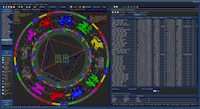Advanced Medieval Module
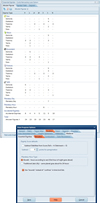
 Because there are multiple dimensions to this examination by astrological author and various periods of history, there is also a Classical / Medieval Group and hundreds of different options grouped by era and author in both the Main Options and Time Lord Options. These include tables for examination of essential dignities and almutens for each of the houses, the almuten figurae which not only gives the planet, but gives all the weight tabulations, Bonatti's degree attributions (masculine, feminine, bright, dark, smoky, empty, welled, azemene and degrees of increasing fortune) for use in Horary and planetary hours either according to sect (the planet that goes about) and the hour (the one that executes) and Firdariyyah with different calculation scenarios based upon sect, where to put the nodes, etc... Many different predomination options are available as well as differences for calculating arabic parts or lots according to sect or based upon other lots, Schmidt's unique distinctions for calculating the Hermetic lots and Valens swapping of fortune and spirit when the lights fall below the horizon. This is just a tiny sample of options which is far too vast to list here, but they are grouped by era in the Main Options and by Time Lord procedure in the Time Lord Options. The Main Options comprise more than 200 separate settings and the Time Lord Settings (excluding Primary Directions) comprise another 230+ settings. Primary directions alone have a total of about 100 different settings (adding the fixed stars brings them to over 1000).
Because there are multiple dimensions to this examination by astrological author and various periods of history, there is also a Classical / Medieval Group and hundreds of different options grouped by era and author in both the Main Options and Time Lord Options. These include tables for examination of essential dignities and almutens for each of the houses, the almuten figurae which not only gives the planet, but gives all the weight tabulations, Bonatti's degree attributions (masculine, feminine, bright, dark, smoky, empty, welled, azemene and degrees of increasing fortune) for use in Horary and planetary hours either according to sect (the planet that goes about) and the hour (the one that executes) and Firdariyyah with different calculation scenarios based upon sect, where to put the nodes, etc... Many different predomination options are available as well as differences for calculating arabic parts or lots according to sect or based upon other lots, Schmidt's unique distinctions for calculating the Hermetic lots and Valens swapping of fortune and spirit when the lights fall below the horizon. This is just a tiny sample of options which is far too vast to list here, but they are grouped by era in the Main Options and by Time Lord procedure in the Time Lord Options. The Main Options comprise more than 200 separate settings and the Time Lord Settings (excluding Primary Directions) comprise another 230+ settings. Primary directions alone have a total of about 100 different settings (adding the fixed stars brings them to over 1000).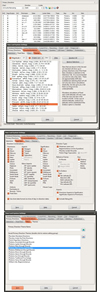
 Due to the split that formed between the middle-Platonic school and the Aristotelian school, one branch which sought the eidetic causes and the other that sought natural causes, there was a debate on what motion represents time. The original meaning of "As Above, So Below" also split in meaning between the ideal and the natural. A natural consequence of this appears to be that Circumambulations which had once sufficed for ideal motion of the heavens and provided one of the definitions for time itself was no longer good enough. Ptolemy objected saying that oblique ascension does not accurately represent the natural motion in all cases. So while these earlier directions may more closely represent the ideal of time, they are not "natural time" and therefore more closely represent the ideal heavens (not the natural heavens). This led to Primary Directions definitions which in Delphic Oracle are based upon Martin Gansten's PDDC Course from which I am a graduate. They closely follow his conventions such as labeling the difference between traditional converse and neo-converse directions and more importantly they stick to traditional conventions for labeling the significator and promissor. All of the direction types of antiquity up to the early modern era are covered; Ptolemy (semi-arc), Regiomontanus (circle of position), Placidus (under the pole) and even Polich-Page Topocentric in both mundane and zodiacal direction types (and various mixed latitude options and keys). The options are quite broad which can be seen in the graphic at left. Over 1100 fixed stars (you can filter by magnitude and ecliptic latitude or declination, the beginnings of filtering redundant directions and of course 19 historical usage themes which the user can add to. Unlike most software, the calculation range is in the neighborhood of 5400 years (15 cycles of 360 degrees) suitable for use in mundane astrology. There is a progress bar and cancel button for these longer calculations and it is on a separate thread to avoid hanging the application.
Due to the split that formed between the middle-Platonic school and the Aristotelian school, one branch which sought the eidetic causes and the other that sought natural causes, there was a debate on what motion represents time. The original meaning of "As Above, So Below" also split in meaning between the ideal and the natural. A natural consequence of this appears to be that Circumambulations which had once sufficed for ideal motion of the heavens and provided one of the definitions for time itself was no longer good enough. Ptolemy objected saying that oblique ascension does not accurately represent the natural motion in all cases. So while these earlier directions may more closely represent the ideal of time, they are not "natural time" and therefore more closely represent the ideal heavens (not the natural heavens). This led to Primary Directions definitions which in Delphic Oracle are based upon Martin Gansten's PDDC Course from which I am a graduate. They closely follow his conventions such as labeling the difference between traditional converse and neo-converse directions and more importantly they stick to traditional conventions for labeling the significator and promissor. All of the direction types of antiquity up to the early modern era are covered; Ptolemy (semi-arc), Regiomontanus (circle of position), Placidus (under the pole) and even Polich-Page Topocentric in both mundane and zodiacal direction types (and various mixed latitude options and keys). The options are quite broad which can be seen in the graphic at left. Over 1100 fixed stars (you can filter by magnitude and ecliptic latitude or declination, the beginnings of filtering redundant directions and of course 19 historical usage themes which the user can add to. Unlike most software, the calculation range is in the neighborhood of 5400 years (15 cycles of 360 degrees) suitable for use in mundane astrology. There is a progress bar and cancel button for these longer calculations and it is on a separate thread to avoid hanging the application.Medieval Square View
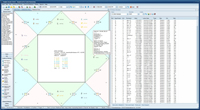
Dark Medieval View
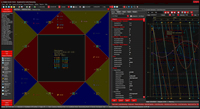
Temporal Quint Wheel View
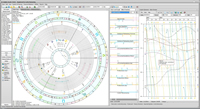
Hellenistic Square View
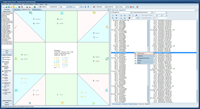
Fixed Stars View
